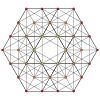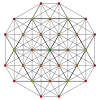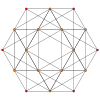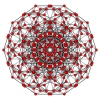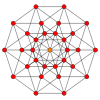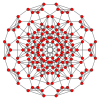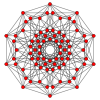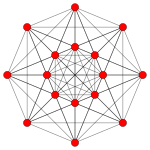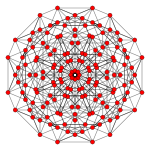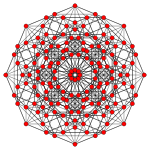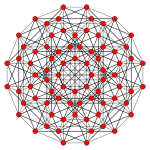Jednolite 5-Polytope - Uniform 5-polytope
|
Nierozwiązany problem w matematyce : Znajdź kompletny zestaw jednolitych 5-polytopes
(więcej nierozwiązanych problemów matematycznych)
|
W geometrii , A jednolity 5 Polytope jest pięć wymiarowe jednolity Polytope . Z definicji, jednolitej 5 Polytope jest wierzchołek-przechodni , a wykonane z jednorodnych 4-Polytope ścianek .
Komplet wypukły jednolitych 5-polytopes nie została ustalona, ale większość z nich może być wykonany w konstrukcji Wythoff z małego zestawu grup symetrii . Te operacje konstrukcyjne są reprezentowane przez permutacje pierścieniach schematów Coxeter .
Zawartość
Historia odkrycia
-
Regularne polytopes : (wypukłe powierzchnie)
- 1852 : Ludwig Schläfli udowodnił w swoim rękopisie Theorie der vielfachen Kontinuität , że nie są dokładnie 3 regularne polytopes w 5 lub większej liczbie wymiarów .
-
Wypukłe semiregular polytopes : (Różne definicje przed Coxeter za jednolitej kategorii)
- 1900 : Thorold Gosset wymienił listę nonprismatic semiregular wypukłych polytopes ze stałymi ściankami ( wypukłe regularne 4-polytopes ) w swojej publikacji na regularnym i Semi-Regular figur w przestrzeni n Wymiary .
-
Wypukłe jednolite polytopes :
- 1940-1988 : Wyszukiwanie została rozszerzona systematycznie przez HSM Coxeter'a w swojej publikacji Regularne i Semi-Regular Polytopes I, II i III .
- 1966 : Norman W. Johnson ukończył doktorat Rozprawa pod Coxeter'a, The Theory of Uniform Polytopes i Honeycombs , University of Toronto
Regularne 5-polytopes
Regularne 5-polytopes może być reprezentowany przez symbol Schläfli {p, q, r, s}, a s, {p, q, r} 4-Polytope ścianek wokół każdej powierzchni . Istnieją dokładnie trzy takie regularne polytopes, wszystkie wypukłe:
- {3,3,3,3} - 5-simplex
- {4,3,3,3} - 5-Cube
- {3,3,3,4} - 5-orthoplex
Brak nonconvex regularne polytopes w 5 lub większej liczbie wymiarów.
Wypukłe jednolity 5 polytopes
104 znane są wypukłe jednolite 5-polytopes oraz szereg nieskończonych rodzin pryzmatów duoprism i duoprisms wielokąta wielościanu. Wszystkie z wyjątkiem wielkiego antygraniastosłup pryzmat oparte są na konstrukcji Wythoff , symetria osiowa generowanego z grup Coxeter .
Symetria jednolitych 5-polytopes cztery wymiary
5-simplex jest regularna forma w 5 rodziną. 5-cube i 5-orthoplex są regularne formy w B 5 rodziną. Wykres rozwidlający kwasu D 5 rodzina zawiera 5-orthoplex , a także 5-demicube który jest naprzemiennie 5-cube .
Każdy odblaskowy jednolity 5 Polytope może być zbudowana z jednej lub większej odblaskowe grupy punktowej w 5 Wymiary przez konstrukcji Wythoff reprezentowanym przez pierścienie wokół permutacji węzłów w schemacie Coxeter . Lustro hiperpłaszczyzny mogą być zgrupowane, jak widać kolorowymi węzłów, oddzielonych nawet odgałęzieniami. Grupy symetrii postaci [a, B, B, A] mają wydłużony symetrii [[A, B, B, A]], takie jak [3,3,3,3] podwojenie kolejność symetrii. Jednolite polytopes w te grupy z symetrycznych pierścieni zawierają tego poszerzonego symetrii.
Jeśli wszystkie zwierciadła o danym kolorze jest unringed (nieaktywne) w danej jednolitej Polytope, to mają mniejszą konstrukcję symetrii, usuwając wszystkie z pozostałych zwierciadeł. Jeśli wszystkie węzły o danym kolorze jest pierścieniowa (aktywny), przyjmuje się naprzemienne działanie może wygenerować nowe 5-Polytope chiralnych symetrii, pokazanego jako „pusta” krążył węzłów”, ale geometria jest ogólnie regulowane, aby tworzyć jednakowe rozwiązania.
- podstawowe rodzin
| Grupa symbol |
Zamówienie | Coxeter wykres |
wspornik notacja |
komutator podgrupa |
Coxeter ilość (H) |
Odbicia m = 5/2 godziny |
||
|---|---|---|---|---|---|---|---|---|
| 5 | 720 | [3,3,3,3] | [3,3,3,3] + | 6 | 15 |
|||
| D 5 | 1920 | [3,3,3 1,1 ] | [3,3,3 1,1 ] + | 8 | 20 |
|||
| B 5 | 3840 | [4,3,3,3] | 10 | 5 |
20 |
|||
- jednolite pryzmaty
Istnieje 5 skończone kategoryczne jednolite pryzmatyczne rodziny polytopes oparciu o nonprismatic jednolitych 4-polytopes . Istnieje jeden nieskończony rodziny 5-polytopes podstawie pryzmatów jednolitych duoprisms {s} P {x} {x}.
|
Coxeter grupa |
Zamówienie |
Coxeter schemat |
Coxeter notacja |
komutator podgrupa |
odbicia | ||||||
|---|---|---|---|---|---|---|---|---|---|---|---|
| 4 1 | 120 | [3,3,3,2] = [3,3,3] x [] | [3,3,3] + | 10 |
1 |
||||||
| D 4 1 | 384 | [3 1,1,1 2] = [3 1,1,1 ] x [] | [3 1,1,1 ] + | 12 |
1 |
||||||
| B 4 1 | 768 | [4,3,3,2] = [4,3,3] x [] | 4 |
12 |
1 |
||||||
| F. 4 1 | 2304 | [3,4,3,2] = [3,4,3] x [] | [3 + , 4,3 + ] | 12 |
12 |
1 |
|||||
| H 4 1 | 28800 | [5,3,3,2] = [3,4,3] x [] | [5,3,3] + | 60 |
1 |
||||||
| Duoprismatic (wykorzystanie 2p i 2q dla Evens) | |||||||||||
| I 2 ( s ) I 2 ( Q ) ± 1 | 8 pq | [P 2, q, 2] = [s] × [Q] x [] | [P + , 2, q + ] |
p |
q |
1 |
|||||
| I 2 (2 s ), I 2 ( Q ) ± 1 | 16 pq | [2p, 2, q, 2] = [2P] × [Q] x [] | p |
p |
q |
1 |
|||||
| I 2 (2 s ), I 2 (2 q ) ± 1 | 32 pq | [2P, 2,2q 2] = [2P] × [2Q] x [] |
p |
p |
q |
q |
1 |
||||
- jednolite duoprisms
Istnieją 3 kategoryczne jednolite duoprismatic rodziny polytopes oparciu o kartezjańskich produktów na jednolitym wielościanów i wielokątów foremnych : { q , r } × { s }.
|
Coxeter grupa |
Zamówienie |
Coxeter schemat |
Coxeter notacja |
komutator podgrupa |
odbicia | ||||||
|---|---|---|---|---|---|---|---|---|---|---|---|
| grupy pryzmatyczne (2p za stosowanie nawet) | |||||||||||
| 3 I 2 ( P ) | 48 str | [3,3,2, t ] = [3,3] x [ s ] | [(3,3) + , 2 p + ] | 6 |
p |
||||||
| 3 I 2 ( 2p ) | 96 str | [3,3,2,2 s ] = [3,3] x [2 P ] | 6 |
p |
p |
||||||
| B 3 I 2 ( P ) | 96 str | [4,3,2, t ] = [4,3] x [ s ] | 3 |
6 |
p |
||||||
| B 3 I 2 ( 2p ) | 192 p | [4,3,2,2 s ] = [4,3] x [2 P ] | 3 |
6 |
p |
p |
|||||
| H 3 I 2 ( P ) | 240 str | [5,3,2, t ] = [5,3] x [ s ] | [(5,3) + , 2 p + ] | 15 |
p |
||||||
| H 3 I 2 ( 2p ) | 480 p | [5,3,2,2 s ] = [5,3] x [2 P ] | 15 |
p |
p |
||||||
Wyliczanie wypukłej ujednolicenie 5-polytopes
-
Simplex Rodzina: 5 [3 4 ]
- 19 jednolity 5-polytopes
-
Hipersześcian / Orthoplex rodziny BC 5 [4,3 3 ]
- 31 jednolity 5-polytopes
-
Demihypercube D 5 / E 5 rodzina [3 2,1,1 ]
- 23 jednolite 5-polytopes (8) unikalne
- Pryzmaty i duoprisms:
- 56 jednolity 5 Polytope (45) unikalnych konstrukcji opiera się na pryzmatycznych rodzin [3,3,3] x [], [4,3,3] x [], [5,3,3] x [], [3 1,1,1 ] x [].
- Jednym z nie Wythoffian - The wielki antygraniastosłup pryzmatu jest jedynym nie Wythoffian wypukły jednolity 5 Polytope, zbudowany z dwóch wielkich antygraniastosłup połączonych wieloboczne graniastosłupów.
To przynosi zgadzają się z: 19 + 31 + 8 + 45 + 1 = 104
Ponadto istnieją:
- Nieskończenie wiele jednolitych konstrukcji 5 Polytope podstawie duoprism pryzmatycznych rodzin: [P] × [Q] x [].
- Nieskończenie wiele jednolitych konstrukcji 5 Polytope podstawie duoprismatic rodzin: [3,3] x [P], [4,3] x [P], [5,3] x [s].
A 5 rodzina
Istnieje 19 formy oparte na wszystkich permutacji diagramów Coxeter z jednym lub większą liczbą pierścieni. (16 + 1/4 przypadków)
Są one nazwane przez Normana Johnson z działalności budowlanej Wythoff upon regularnej 5-simplex (hexateron).
5 rodzina ma symetrii obrotowej o uporządkowaniu 720 (6 silnia ). 7 z figury 19, z symetrycznie pierścieniowych schematów Coxeter podwoiła symetrii kolejności 1440.
Współrzędne jednolitych 5-polytopes z 5-simplex symetrii może być generowany permutacji prostych liczb w przestrzeni 6, a wszystko to w hiperplaszczyzn z wektora normalnego (1,1,1,1,1,1).
| # | Punkt bazowy |
Johnson nazewnictwa systemu imię i Bowers (skrót) Coxeter schemat |
Liczy elementów k-face |
Vertex figura |
Facet liczy według lokalizacji: [3,3,3,3] | ||||||||
|---|---|---|---|---|---|---|---|---|---|---|---|---|---|
| 4 | 3 | 2 | 1 | 0 |
[3,3,3], (6) |
[3,3,2], (15) |
[3,2,3], (20) |
[2,3,3], (15) |
[3,3,3], (6) |
||||
| 1 | (0,0,0,0,0,1) lub (0,1,1,1,1,1) |
5-simplex hexateron (Hiksa) |
6 | 15 | 20 | 15 | 6 |
 {3,3,3} |
(5) {3,3,3} |
- | - | - | - |
| 2 | (0,0,0,0,1,1) lub (0,0,1,1,1,1) |
Wyprostowany 5-simplex usunięte hexateron (RIX) |
12 | 45 | 80 | 60 | 15 |
 T {3,3} {x} |
(4) R {3,3,3} |
- | - | - | (2) {3,3,3} |
| 3 | (0,0,0,0,1,2) lub (0,1,2,2,2,2) |
Ściętego 5-simplex ściętego hexateron (tix) |
12 | 45 | 80 | 75 | 30 |
 Tetrah.pyr |
(4) T {3,3,3} |
- | - | - | (1) {3,3,3} |
| 4 | (0,0,0,1,1,2) lub (0,1,1,2,2,2) |
Cantellated 5-simplex małe rhombated hexateron (sarx) |
27 | 135 | 290 | 240 | 60 |
Pryzmat klin |
(3) rr {3,3,3} |
- | - | (1) |
(1) R {3,3,3} |
| 5 | (0,0,0,1,2,2) lub (0,0,1,2,2,2) |
Bitruncated 5-simplex bitruncated hexateron (bittix) |
12 | 60 | 140 | 150 | 60 |

|
(3) 2t {3,3,3} |
- | - | - | (2) t {3,3,3} |
| 6 | (0,0,0,1,2,3) lub (0,1,2,3,3,3) |
Cantitruncated 5-simplex wielki rhombated hexateron (garx) |
27 | 135 | 290 | 300 | 120 |

|
 tr {3,3,3} |
- | - |
|
 T {3,3,3} |
| 7 | (0,0,1,1,1,2) lub (0,1,1,1,2,2) |
Runcinated 5-simplex małe prismated hexateron (Spix) |
47 | 255 | 420 | 270 | 60 |

|
(2) t 0,3 {3,3,3} |
- | (3) {3}, {3} x |
(3) |
(1) R {3,3,3} |
| 8 | (0,0,1,1,2,3) lub (0,1,2,2,3,3) |
Runcitruncated 5-simplex prismatotruncated hexateron (pattix) |
47 | 315 | 720 | 630 | 180 |

|
 t 0,1,3 {3,3,3} |
- |
|
|
 rr {3,3,3} |
| 9 | (0,0,1,2,2,3) lub (0,1,1,2,3,3) |
Runcicantellated 5-simplex prismatorhombated hexateron (Pirx) |
47 | 255 | 570 | 540 | 180 |

|
 t 0,1,3 {3,3,3} |
- |
 {3}, {3} x |
|
 2t {3,3,3} |
| 10 | (0,0,1,2,3,4) lub (0,1,2,3,4,4) |
Runcicantitruncated 5-simplex wielki prismated hexateron (gippix) |
47 | 315 | 810 | 900 | 360 |
 IRR. 5-komórka |
 t 0,1,2,3 {3,3,3} |
- |
|
|
 rr {3,3,3} |
| 11 | (0,1,1,1,2,3) lub (0,1,2,2,2,3) |
Steritruncated 5-simplex celliprismated hexateron (cappix) |
62 | 330 | 570 | 420 | 120 |

|
 T {3,3,3} |
|
|
|
 T 0,3 {3,3,3} |
| 12 | (0,1,1,2,3,4) lub (0,1,2,3,3,4) |
Stericantitruncated 5-simplex celligreatorhombated hexateron (cograx) |
62 | 480 | 1140 | 1080 | 360 |
|
 tr {3,3,3} |
|
|
|
 t 0,1,3 {3,3,3} |
| # | Punkt bazowy |
Johnson nazewnictwa systemu imię i Bowers (skrót) Coxeter schemat |
Liczy elementów k-face |
Vertex figura |
Facet liczy według lokalizacji: [3,3,3,3] | ||||||||
|---|---|---|---|---|---|---|---|---|---|---|---|---|---|
| 4 | 3 | 2 | 1 | 0 |
[3,3,3], (6) |
[3,3,2], (15) |
[3,2,3], (20) |
[2,3,3], (15) |
[3,3,3], (6) |
||||
| 13 | (0,0,0,1,1,1) |
Birectified 5-simplex dodecateron (kropka) |
12 | 60 | 120 | 90 | 20 |
 {3}, {3} x |
(3) R {3,3,3} |
- | - | - | (3) R {3,3,3} |
| 14 | (0,0,1,1,2,2) |
Bicantellated 5-simplex małe birhombated dodecateron (sibrid) |
32 | 180 | 420 | 360 | 90 |

|
(2) rr {3,3,3} |
- | (8) {3}, {3} x |
- | (2) rr {3,3,3} |
| 15 | (0,0,1,2,3,3) |
Bicantitruncated 5-simplex wielki birhombated dodecateron (gibrid) |
32 | 180 | 420 | 450 | 180 |

|
 tr {3,3,3} |
- |
 {3}, {3} x |
- |
 tr {3,3,3} |
| 16 | (0,1,1,1,1,2) |
Stericated 5-simplex małe cellated dodecateron (scad) |
62 | 180 | 210 | 120 | 30 |
 IRR. 16 komórek |
(1) {3,3,3} |
(4) |
(6) {3}, {3} x |
(4) |
(1) {3,3,3} |
| 17 | (0,1,1,2,2,3) |
Stericantellated 5-simplex mały cellirhombated dodecateron (karta) |
62 | 420 | 900 | 720 | 180 |

|
 rr {3,3,3} |
|
 {3}, {3} x |
|
 rr {3,3,3} |
| 18 | (0,1,2,2,3,4) |
Steriruncitruncated 5-simplex celliprismatotruncated dodecateron (captid) |
62 | 450 | 1110 | 1080 | 360 |
|
 t 0,1,3 {3,3,3} |
|
 {6} x {6} |
|
 t 0,1,3 {3,3,3} |
| 19 | (0,1,2,3,4,5) |
Omnitruncated 5-simplex wielki cellated dodecateron (gocad) |
62 | 540 | 1.560 | 1800 | 720 |
 IRR. {3,3,3} |
(1) T 0,1,2,3 {3,3,3} |
(1) |
(1) {6} x {6} |
(1) |
(1) T 0,1,2,3 {3,3,3} |
B 5 rodzina
B 5 rodzina ma symetrię rzędu 3840 (5! X 2 5 ).
Ta rodzina 2 5 -1 = 31 Wythoffian jednolite polytopes generowane poprzez oznaczenie jednej lub większej liczby węzłów w schemacie Coxeter .
Dla uproszczenia jest ona podzielona na dwie podgrupy, z których każda 12 formy, oraz 7 „średnich” formy, który równie należą zarówno.
Rodzina 5-cube 5-polytopes podane przez kadłubów wypukłych punktów bazowych wymienionych w poniższej tabeli, z wszystkich permutacji współrzędnych i podpisać podjęte. Każdy punkt podstawy tworzy odrębną jednolite 5-Polytope. Wszystkie wielkości odpowiadają jednolitych 5-polytopes długości krawędzi 2.
| # | Punkt bazowy | Imię Coxeter schemat |
Element liczy |
Vertex figura |
Facet liczy według lokalizacji: [4,3,3,3] | ||||||||
|---|---|---|---|---|---|---|---|---|---|---|---|---|---|
| 4 | 3 | 2 | 1 | 0 |
[4,3,3], (10) |
[4,3,2], (40) |
[4,2,3], (80) |
[2,3,3], (80) |
[3,3,3], (32) |
||||
| 20 | (0,0,0,0,1) √2 |
5-orthoplex (TAC) |
32 | 80 | 80 | 40 | 10 |
 {3,3,4} |
 {3,3,3} |
- | - | - | - |
| 21 | (0,0,0,1,1) √2 |
Wyprostowany 5 orthoplex (szczur) |
42 | 240 | 400 | 240 | 40 |
 {X} {3,4} |
 {3,3,4} |
- | - | - |
 R {3,3,3} |
| 22 | (0,0,0,1,2) √2 |
Ściętego 5 orthoplex (tot) |
42 | 240 | 400 | 280 | 80 |
 (Octah.pyr) |
 T {3,3,3} |
 {3,3,3} |
- | - | - |
| 23 | (0,0,1,1,1) √2 |
Birectified 5-cube (NIT) (Birectified 5-orthoplex) |
42 | 280 | 640 | 480 | 80 |
 {4} x {3} |
 R {3,3,4} |
- | - | - |
 R {3,3,3} |
| 24 | (0,0,1,1,2) √2 |
Cantellated 5 orthoplex (SART) |
82 | 640 | 1520 | 1200 | 240 |
 Pryzmat klin |
R {3,3,4} | {X} {3,4} | - | - |
 rr {3,3,3} |
| 25 | (0,0,1,2,2) √2 |
Bitruncated 5 orthoplex (bittit) |
42 | 280 | 720 | 720 | 240 |  |
T {3,3,4} | - | - | - |
 2t {3,3,3} |
| 26 | (0,0,1,2,3) √2 |
Cantitruncated 5 orthoplex (gart) |
82 | 640 | 1520 | 1440 | 480 |  |
rr {3,3,4} | {R} x {3,4} |
 {6} x {4} |
- |
 t 0,1,3 {3,3,3} |
| 27 | (0,1,1,1,1) √2 |
Rektyfikowany 5-cube (Rin) |
42 | 200 | 400 | 320 | 80 |
 {3,3} {x} |
 R {4,3,3} |
- | - | - |
 {3,3,3} |
| 28 | (0,1,1,1,2) √2 |
Runcinated 5 orthoplex (kamasz) |
162 | 1200 | 2160 | 1440 | 320 |  |
R {4,3,3} | - |
 {3} x {4} |
 T 0,3 {3,3,3} |
|
| 29 | (0,1,1,2,2) √2 |
Bicantellated 5-cube (sibrant) (Bicantellated 5-orthoplex) |
122 | 840 | 2160 | 1920 | 480 |  |
 rr {4,3,3} |
- |
 {4} x {3} |
- |
 rr {3,3,3} |
| 30 | (0,1,1,2,3) √2 |
Runcitruncated 5 orthoplex (pattit) |
162 | 1440 | 3680 | 3360 | 960 |  |
rr {3,3,4} | {R} x {3,4} |
 {6} x {4} |
- |
 t 0,1,3 {3,3,3} |
| 31 | (0,1,2,2,2) √2 |
Bitruncated 5-cube (TAN) |
42 | 280 | 720 | 800 | 320 |  |
 2t {4,3,3} |
- | - | - |
 T {3,3,3} |
| 32 | (0,1,2,2,3) √2 |
Runcicantellated 5 orthoplex (Pirt) |
162 | 1200 | 2960 | 2880 | 960 |  |
{T} x {3,4} | 2t {3,3,4} |
 {3} x {4} |
- |
 t 0,1,3 {3,3,3} |
| 33 | (0,1,2,3,3) √2 |
Bicantitruncated 5-cube (gibrant) (Bicantitruncated 5-orthoplex) |
122 | 840 | 2160 | 2400 | 960 |  |
 rr {4,3,3} |
- |
 {4} x {3} |
- |
 rr {3,3,3} |
| 34 | (0,1,2,3,4) √2 |
Runcicantitruncated 5 orthoplex (gippit) |
162 | 1440 | 4160 | 4800 | 1920 |  |
tr {3,3,4} | {T} x {3,4} |
 {6} x {4} |
- |
 t 0,1,2,3 {3,3,3} |
| 35 | (1,1,1,1,1) |
5-cube (pent) |
10 | 40 | 80 | 80 | 32 |
 {3,3,3} |
 {4,3,3} |
- | - | - | - |
| 36 | (1,1,1,1,1) + (0,0,0,0,1) √2 |
Stericated 5-cube (skąpe) (Stericated 5-orthoplex) |
242 | 800 | 1040 | 640 | 160 |
 Tetr.antiprm |
 {4,3,3} |
 {4,3} {x} |
 {4} x {3} |
 {X} {3,3} |
 {3,3,3} |
| 37 | (1,1,1,1,1) + (0,0,0,1,1) √2 |
Runcinated 5-cube (zakres) |
202 | 1240 | 2160 | 1440 | 320 |  |
 T 0,3 {4,3,3} |
- |
 {4} x {3} |
 {R} x {3,3} |
 {3,3,3} |
| 38 | (1,1,1,1,1) + (0,0,0,1,2) √2 |
Steritruncated 5 orthoplex (cappin) |
242 | 1520 | 2880 | 2240 | 640 |  |
T 0,3 {3,3,4} | {X} {4,3} | - | - |
 T {3,3,3} |
| 39 | (1,1,1,1,1) + (0,0,1,1,1) √2 |
Cantellated 5-cube (sirn) |
122 | 680 | 1520 | 1280 | 320 |
Pryzmat klin |
 rr {4,3,3} |
- | - |
 {X} {3,3} |
 R {3,3,3} |
| 40 | (1,1,1,1,1) + (0,0,1,1,2) √2 |
Stericantellated 5-cube (carnit) (Stericantellated 5-orthoplex) |
242 | 2080 | 4720 | 3840 | 960 |  |
 rr {4,3,3} |
 rr {4,3} {x} |
 {4} x {3} |
 Rr} {x {3,3} |
 rr {3,3,3} |
| 41 | (1,1,1,1,1) + (0,0,1,2,2) √2 |
Runcicantellated 5-cube (wliczony) |
202 | 1240 | 2960 | 2880 | 960 |  |
 t 0,1,3 {4,3,3} |
- |
 {4} x {3} |
 {T} x {3,3} |
 2t {3,3,3} |
| 42 | (1,1,1,1,1) + (0,0,1,2,3) √2 |
Stericantitruncated 5 orthoplex (cogart) |
242 | 2320 | 5920 | 5760 | 1920 |
 Rr} {x {3,4} |
 t 0,1,3 {3,3,4} |
 {6} x {4} |
 {T} x {3,3} |
 tr {3,3,3} |
|
| 43 | (1,1,1,1,1) + (0,1,1,1,1) √2 |
Ściętego 5-cube (TAN) |
42 | 200 | 400 | 400 | 160 |
 Tetrah.pyr |
 T {4,3,3} |
- | - | - |
 {3,3,3} |
| 44 | (1,1,1,1,1) + (0,1,1,1,2) √2 |
Steritruncated 5-cube (kpt) |
242 | 1.600 | 2960 | 2240 | 640 |  |
 T {4,3,3} |
 T {4,3} {x} |
 {8} x {3} |
 {X} {3,3} |
 T 0,3 {3,3,3} |
| 45 | (1,1,1,1,1) + (0,1,1,2,2) √2 |
Runcitruncated 5-cube (pattin) |
202 | 1.560 | 3760 | 3360 | 960 |  |
 t 0,1,3 {4,3,3} |
{T} x {4,3} |
 {6} x {8} |
{T} x {3,3} | t 0,1,3 {3,3,3}]] |
| 46 | (1,1,1,1,1) + (0,1,1,2,3) √2 |
Steriruncitruncated 5-cube (captint) (Steriruncitruncated 5-orthoplex) |
242 | 2160 | 5760 | 5760 | 1920 |
 t 0,1,3 {4,3,3} |
 T {4,3} {x} |
 {8} x {6} |
 {T} x {3,3} |
 t 0,1,3 {3,3,3} |
|
| 47 | (1,1,1,1,1) + (0,1,2,2,2) √2 |
Cantitruncated 5-cube (girn) |
122 | 680 | 1520 | 1.600 | 640 |  |
 tr {4,3,3} |
- | - |
 {X} {3,3} |
 T {3,3,3} |
| 48 | (1,1,1,1,1) + (0,1,2,2,3) √2 |
Stericantitruncated 5-cube (cogrin) |
242 | 2400 | 6000 | 5760 | 1920 |
 tr {4,3,3} |
 tr {4,3} {x} |
 {8} x {3} |
 {T} x 0,2 {3,3} |
 t 0,1,3 {3,3,3} |
|
| 49 | (1,1,1,1,1) + (0,1,2,3,3) √2 |
Runcicantitruncated 5-cube (gippin) |
202 | 1.560 | 4240 | 4800 | 1920 |  |
 t 0,1,2,3 {4,3,3} |
- |
 {8} x {3} |
 {T} x {3,3} |
 tr {3,3,3} |
| 50 | (1,1,1,1,1) + (0,1,2,3,4) √2 |
Omnitruncated 5-cube (gacnet) (omnitruncated 5-orthoplex) |
242 | 2640 | 8160 | 9600 | 3840 |
 IRR. {3,3,3} |
 tr {4,3} {x} |
 tr {4,3} {x} |
 {8} x {6} |
 {} Tr x {3,3} |
 t 0,1,2,3 {3,3,3} |
D 5 rodzina
D 5 rodzina ma symetrię rzędu 1920 (5! 2 x 4 ).
Ta rodzina 23 Wythoffian jednolitego wielościany, z 3x8-1 permutacji D 5 Coxeter wykresie z jednym lub większą liczbą pierścieni. 15 (2x8-1) powtarza się z B 5 rodziny i 8 są unikalne dla tej rodziny.
| # |
Coxeter schemat symbol schläfliego symbole nazwy Johnson Bowers |
Element liczy |
Vertex figura |
Aspektów od położenia: |
||||||||
|---|---|---|---|---|---|---|---|---|---|---|---|---|
| 4 | 3 | 2 | 1 | 0 |
[3,3,3], (16) |
[3 1,1,1 ], (10) |
[3,3] x [], (40) |
[X] [3] x [], (80) |
[3,3,3], (16) |
|||
| 51 |
|
26 | 120 | 160 | 80 | 16 |
 t 1 {3,3,3} |
{3,3,3} | t 0 (1 11 ) | - | - | - |
| 52 |
|
42 | 280 | 640 | 560 | 160 |

|
|||||
| 53 |
|
42 | 360 | 880 | 720 | 160 | ||||||
| 54 |
|
82 | 480 | 720 | 400 | 80 | ||||||
| 55 |
|
42 | 360 | 1040 | 1200 | 480 | ||||||
| 56 |
|
82 | 720 | 1840 | 1.680 | 480 | ||||||
| 57 |
|
82 | 560 | 1280 | 1120 | 320 | ||||||
| 58 |
|
82 | 720 | 2080 | 2400 | 960 | ||||||
Jednolite formy pryzmatyczne
Istnieje 5 skończone kategoryczne jednolite pryzmatyczne rodziny polytopes oparciu o nonprismatic jednolitych 4-polytopes :
4 x 1
Ta rodzina pryzmatyczny 9 stanowi :
1 x A 4 rodziny ma symetrię rzędu 240 (2 * 5!).
| # |
Coxeter schemat i Schläfli symbole Nazwa |
Element liczy | ||||
|---|---|---|---|---|---|---|
| fasety | Komórki | twarze | Obrzeża | wierzchołki | ||
| 59 |
pryzmat 5-komórka |
7 | 20 | 30 | 25 | 10 |
| 60 |
rektyfikacyjny 5 komórek pryzmat |
12 | 50 | 90 | 70 | 20 |
| 61 |
ścięty 5 komórek pryzmat |
12 | 50 | 100 | 100 | 40 |
| 62 |
Cantellated 5 komórek pryzmat |
22 | 120 | 250 | 210 | 60 |
| 63 |
Runcinated 5 komórek pryzmat |
32 | 130 | 200 | 140 | 40 |
| 64 |
Bitruncated 5 komórek pryzmat |
12 | 60 | 140 | 150 | 60 |
| 65 |
Cantitruncated 5 komórek pryzmat |
22 | 120 | 280 | 300 | 120 |
| 66 |
Runcitruncated 5 komórek pryzmat |
32 | 180 | 390 | 360 | 120 |
| 67 |
Omnitruncated 5 komórek pryzmat |
32 | 210 | 540 | 600 | 240 |
B 4 x 1
Ta rodzina ma pryzmatyczny 16 formy . (Trzy są udostępniane [3,4,3] x [] Rodzina)
1 x B 4 rodziny ma symetrię rzędu 768 (2 5 4!).
| # |
Coxeter schemat i Schläfli symbole Nazwa |
Element liczy | ||||
|---|---|---|---|---|---|---|
| fasety | Komórki | twarze | Obrzeża | wierzchołki | ||
| [16] |
Tesseractic pryzmatu (taki sam jak 5-cube ) |
10 | 40 | 80 | 80 | 32 |
| 68 |
rektyfikacyjny tesseractic pryzmat |
26 | 136 | 272 | 224 | 64 |
| 69 |
przycinany tesseractic pryzmat |
26 | 136 | 304 | 320 | 128 |
| 70 |
Cantellated tesseractic pryzmat |
58 | 360 | 784 | 672 | 192 |
| 71 |
Runcinated tesseractic pryzmat |
82 | 368 | 608 | 448 | 128 |
| 72 |
Bitruncated tesseractic pryzmat |
26 | 168 | 432 | 480 | 192 |
| 73 |
Cantitruncated tesseractic pryzmat |
58 | 360 | 880 | 960 | 384 |
| 74 |
Runcitruncated tesseractic pryzmat |
82 | 528 | 1216 | 1152 | 384 |
| 75 |
Omnitruncated tesseractic pryzmat |
82 | 624 | 1696 | 1920 | 768 |
| 76 |
pryzmat 16 komórek |
18 | 64 | 88 | 56 | 16 |
| 77 |
rektyfikacyjny 16 komórek pryzmatu (tak samo jak pryzmat 24 komórek ) |
26 | 144 | 288 | 216 | 48 |
| 78 |
ścięty 16 komórek pryzmat |
26 | 144 | 312 | 288 | 96 |
| 79 |
Cantellated pryzmat 16 komórek (tak samo jak wyprostowanego pryzmat 24 komórek ) |
50 | 336 | 768 | 672 | 192 |
| 80 |
Cantitruncated 16 komórek pryzmatu (tak samo jak ściętego pryzmat 24 komórek ) |
50 | 336 | 864 | 960 | 384 |
| 81 |
Runcitruncated 16 komórek pryzmat |
82 | 528 | 1216 | 1152 | 384 |
| 82 |
zakotwiczenia pryzmat 24 komórek |
146 | 768 | 1392 | 960 | 192 |
F. 4 x 1
Ta rodzina ma pryzmatyczny 10 formy .
1 x F 4 rodziny ma symetrię rzędu 2304 (2 x 1152). Trzy polytopes 85, 86 i 89 (zielone tło) ma podwójną symetrię [[3,4,3] 2], a porządek 4608. Ten ostatni, zakotwiczenia pryzmat 24 komórek, (tło) w [3 + , 4, 3,2] symetrii, kolejność 1152.
| # |
Coxeter schemat i Schläfli symbole Nazwa |
Element liczy | ||||
|---|---|---|---|---|---|---|
| fasety | Komórki | twarze | Obrzeża | wierzchołki | ||
| [77] |
pryzmat 24 komórek |
26 | 144 | 288 | 216 | 48 |
| [79] |
usunięte 24-komórkowej pryzmatu |
50 | 336 | 768 | 672 | 192 |
| [80] |
obcięty 24-komórkowej pryzmatu |
50 | 336 | 864 | 960 | 384 |
| 83 |
cantellated 24-komórkowej pryzmatu |
146 | 1008 | 2304 | 2016 | 576 |
| 84 |
runcinated 24-komórkowej pryzmatu |
242 | 1152 | 1920 | 1296 | 288 |
| 85 |
bitruncated 24-komórkowej pryzmatu |
50 | 432 | 1248 | 1440 | 576 |
| 86 |
cantitruncated 24-komórkowej pryzmatu |
146 | 1008 | 2592 | 2880 | 1152 |
| 87 |
runcitruncated 24-komórkowej pryzmatu |
242 | 1584 | 3648 | 3456 | 1152 |
| 88 |
omnitruncated 24-komórkowej pryzmatu |
242 | 1872 | 5088 | 5760 | 2304 |
| [82] |
zakotwiczenia pryzmat 24 komórek |
146 | 768 | 1392 | 960 | 192 |
H 4 x 1
Ta rodzina ma pryzmatyczny 15 formularzy :
1 x H 4 rodziny ma symetrię rzędu 28800 (2 x 14400).
| # |
Coxeter schemat i Schläfli symbole Nazwa |
Element liczy | ||||
|---|---|---|---|---|---|---|
| fasety | Komórki | twarze | Obrzeża | wierzchołki | ||
| 89 |
pryzmat 120 komórek |
122 | 960 | 2640 | 3000 | 1200 |
| 90 |
rektyfikacyjny 120 komórek pryzmat |
722 | 4560 | 9840 | 8400 | 2400 |
| 91 |
ścięty 120 komórek pryzmat |
722 | 4560 | 11040 | 12000 | 4800 |
| 92 |
Cantellated 120 komórek pryzmat |
1922 | 12960 | 29040 | 25200 | 7200 |
| 93 |
Runcinated 120 komórek pryzmat |
2642 | 12720 | 22080 | 16800 | 4800 |
| 94 |
Bitruncated 120 komórek pryzmat |
722 | 5760 | 15840 | 18000 | 7200 |
| 95 |
Cantitruncated 120 komórek pryzmat |
1922 | 12960 | 32640 | 36000 | 14400 |
| 96 |
Runcitruncated 120 komórek pryzmat |
2642 | 18720 | 44880 | 43200 | 14400 |
| 97 |
Omnitruncated 120 komórek pryzmat |
2642 | 22320 | 62880 | 72000 | 28800 |
| 98 |
pryzmat 600 komórek |
602 | 2400 | 3120 | 1.560 | 240 |
| 99 |
rektyfikacyjny 600 komórek pryzmat |
722 | 5040 | 10800 | 7920 | 1440 |
| 100 |
ścięty 600 komórek pryzmat |
722 | 5040 | 11520 | 10080 | 2880 |
| 101 |
Cantellated 600 komórek pryzmat |
1442 | 11520 | 28080 | 25200 | 7200 |
| 102 |
Cantitruncated 600 komórek pryzmat |
1442 | 11520 | 31680 | 36000 | 14400 |
| 103 |
Runcitruncated 600 komórek pryzmat |
2642 | 18720 | 44880 | 43200 | 14400 |
Wielki antygraniastosłup pryzmat
Wielki antygraniastosłup pryzmatu jest jedynym wypukły nie Wythoffian jednolity 5 Polytope. Ma 200 wierzchołki 1100 krawędzie 1940 powierzchnie (40 pięciokątów, 500 kwadraty 1400 trójkąty) 1360 komórek (600 tetraedrów , 40 pięciokątnych antygraniastosłup , 700 trójkątne pryzmatów , 20 pięciokątne pryzmatów ) i 322 hypercells (2 wielkie antygraniastosłup  , 20 pięciokątnych antygraniastosłup pryzmaty
, 20 pięciokątnych antygraniastosłup pryzmaty  i 300 tetraedryczne pryzmatów
i 300 tetraedryczne pryzmatów  ).
).
| # | Imię | Element liczy | ||||
|---|---|---|---|---|---|---|
| fasety | Komórki | twarze | Obrzeża | wierzchołki | ||
| 104 |
Wielki antygraniastosłup pryzmat Gappip |
322 | 1.360 | 1940 | 1100 | 200 |
Uwagi dotyczące budowy Wythoff dla jednolitych 5-polytopes
Konstrukcja odblaskowe 5-wymiarowych jednolitych polytopes są wykonywane za pomocą konstrukcji Wythoff procesu i reprezentowane przez schemat Coxeter , gdzie każdy węzeł reprezentuje lustro. Węzły są obrączkowane sugerować który lusterka są aktywne. Pełny zestaw jednolitych polytopes generowane są na podstawie unikalnych permutacji zaobrączkowanych węzłów. Jednolite 5-polytopes są nazwane w stosunku do regularnych polytopes w każdej rodzinie. Niektóre rodziny mają dwa regularne konstruktorów, a tym samym może mieć dwa sposoby ich nazywania.
Oto podstawowe operatory dostępne dla budowy i nazewnictwa jednolitych 5-polytopes.
Ostatnia operacja The afront, a bardziej ogólnie naprzemienne, to operacja, która może tworzyć formularze nonreflective. Te pochodzą z „zamkniętych pierścieni” w węzłach.
Pryzmatyczne formy i wykresy rozwidlających można użyć tej samej notacji obcięcie indeksowania, ale wymaga wyraźnej system numeracji na węzłach dla jasności.
| Operacja | Rozszerzony symbol Schläfli |
Coxeter schemat | Opis | |
|---|---|---|---|---|
| Rodzic | t 0 {p, q, r, s} | {P, q, r, s} |
|
Wszelkie regularne 5-Polytope |
| rektyfikowany | t 1 {p, q, r, s} | R {p, q, r, s} |
|
Krawędzie są całkowicie obcięte do pojedynczych punktów. 5-Polytope ma teraz połączone twarze rodziców i podwójny. |
| Birectified | T 2 {p, q, r, s} | 2r {p, q, r, s} |
|
Birectification zmniejsza twarze punktów komórki do swoich felg bliźniaczych . |
| Trirectified | T 3 {p, q, r, s} | 3r {p, q, r, s} |
|
Trirectification redukuje komórki do punktów. (Podwójny rektyfikacji) |
| Quadrirectified | t 4 {p, q, r, s} | 4r {p, q, r, s} |
|
Quadrirectification zmniejsza 4-twarze punktów. (Podwójny) |
| Kadłubowy | T 0,1 {p, q, r, s} | T {p, q, r, s} |
|
Każda oryginalna wierzchołek jest odcięta, z nową twarzą wypełnienie luki. Obcięcie ma stopień swobody, który ma jedno rozwiązanie, które tworzy jednolitą obcięty 5-Polytope. 5-Polytope ma swoje oryginalne twarze podwoiła się stron i zawiera twarze podwójny.
|
| Cantellated | T 0,2 {p, q, r, s} | rr {p, q, r, s} |
|
Oprócz obcięcia wierzchołków, z których każda jest oryginalna krawędź fazowane z nowych twarzy prostokątnych pojawiających się na ich miejscu.
|
| Runcinated | T 0,3 {p, q, r, s} |
|
Runcination redukuje komórki i tworzy nowe komórki w wierzchołkach i krawędziach. | |
| Stericated | T 0,4 {p, q, r, s} | 2r2r {p, q, r, s} |
|
Sterication zmniejsza aspekty i tworzy nowe aspekty (hypercells) przy wierzchołkach i krawędziach luki. (Taki sam jak rozszerzenie działanie na 5-polytopes). |
| Omnitruncated | t 0,1,2,3,4 {p, q, r, s} |
|
Wszystkich czterech operatorów, obcięcie, cantellation, runcination i sterication są stosowane. | |
| Pół | H {2p, 3, q, r} |
|
Przemienności , tak samo jak |
|
| Cantic | H 2 {2p, 3, q, r} |
|
Taki sam jak |
|
| Runcic | H 3 {2p, 3, q, r} |
|
Taki sam jak |
|
| Runcicantic | H 2,3 {2p, 3, q, r} |
|
Taki sam jak |
|
| zawada | H 4 {2p, 3, q, r} |
|
Taki sam jak |
|
| Runcisteric | H 3,4 {2p, 3, q, r} |
|
Taki sam jak |
|
| Stericantic | H 2,4 {2p, 3, q, r} |
|
Taki sam jak |
|
| Steriruncicantic | H 2,3,4 {2p, 3, q, r} |
|
Taki sam jak |
|
| Odkosz | s {s, 2q, R, S} |
|
przemian obcięcie | |
| zadartym naprawione | SR {p, q, 2R, S} |
|
Przemian obcięty sprostowanie | |
| HT 0,1,2,3 {p, q, r, s} |
|
przemian runcicantitruncation | ||
| Pełna zadartym | HT 0,1,2,3,4 {p, q, r, s} |
|
przemian omnitruncation | |
Regularne i jednolite plastrach
Istnieje pięć podstawowych afiniczne grupy Coxeter i 13 grupy pryzmatyczne, które generują regularne i jednolite TESELACJE w euklidesowej 4 miejsca.
| # | grupa Coxetera | Coxeter schemat | formularze | ||
|---|---|---|---|---|---|
| 1 | [3 [5] ] | [(3,3,3,3,3)] | 7 | ||
| 2 | [4,3,3,4] | 19 | |||
| 3 | [4,3,3 1,1 ] | [4,3,3,4,1 + ] |
|
23 (8 nowy) | |
| 4 | [3 1,1,1,1 ] | [1 + , 4,3,3,4,1 + ] |
|
9 (0 nowy) | |
| 5 | [3,4,3,3] | 31 (21 nowy) | |||
Istnieją trzy regularne plastry miodu z euklidesowej 4-space:
-
tesseractic o strukturze plastra miodu , z symboli {4,3,3,4}








 =
= 





 . Istnieje 19 jednolite plastrach w tej rodzinie.
. Istnieje 19 jednolite plastrach w tej rodzinie. -
24 o strukturze plastra miodu z komórkami , symbole {3,4,3,3}








 . Istnieje 31 odblaskowe jednolite plastrach w tej rodzinie, a jedna forma naprzemiennie.
. Istnieje 31 odblaskowe jednolite plastrach w tej rodzinie, a jedna forma naprzemiennie.
-
Ściętego o strukturze plastra miodu 24 komórek z symboli t {3,4,3,3}









-
Zakotwiczenia plastra miodu 24 komórek z symboli S {3,4,3,3}








 i
i 







 skonstruowano cztery zadartym 24 komórek , jeden 16 komórek i pięć 5 komórek na każdym wierzchołku.
skonstruowano cztery zadartym 24 komórek , jeden 16 komórek i pięć 5 komórek na każdym wierzchołku.
-
Ściętego o strukturze plastra miodu 24 komórek z symboli t {3,4,3,3}
-
16 o strukturze plastra miodu z komórkami , symbole {3,3,4,3}









Inne rodziny, które generują jednolitych plastrach:
- Istnieje 23 unikalnie obrączkowane formy, 8 nowych w strukturze plastra miodu, 16-komórkowej rodziny. Z symbolami h {4,3 2 4} jest geometrycznie identyczne z plastra miodu 16 komórek ,








 =
=






- Istnieje 7 jednoznacznie obrączkowane od formy , rodzina, nowy, w tym:





- Istnieje 9 wyjątkowo ringed formy w [3 1,1,1,1 ] rodziny, dwa nowe, w tym ćwierć tesseractic plastra miodu , = , a bitruncated tesseractic plastra miodu , = .

































Dla Wythoffian jednolite TESELACJE w 4 miejsca występują również wydłużenie (warstwy) wstawiania i bezwładności (obracanie warstwy) odbijających z tych form.
| # | grupa Coxetera | Coxeter schemat | |
|---|---|---|---|
| 1 | × | [4,3,4,2, ∞] |
|
| 2 | × | [4,3- 1,1 , 2, ∞] |
|
| 3 | × | [3 [4] , 2, ∞] |
|
| 4 | × x | [4,4,2, ∞, 2, ∞] |
|
| 5 | × x | [6,3,2, ∞, 2, ∞] |
|
| 6 | × x | [3 [3] , 2, ∞, 2, ∞] |
|
| 7 | × x x | [∞, 2, ∞, 2, ∞, 2, ∞] |
|
| 8 | x | [3 [3] 2,3 [3] ] |
|
| 9 | × | [3 [3] , 2,4,4] |
|
| 10 | × | [3 [3] , 2,6,3] |
|
| 11 | × | [4,4,2,4,4] |
|
| 12 | × | [4,4,2,6,3] |
|
| 13 | × | [6,3,2,6,3] |
|
Kompaktowe regularne TESELACJE z 4-przestrzeni hiperbolicznej
Istnieje pięć rodzajów wypukłych zwykłych plastrów i cztery rodzaje gwiezdnych plastrach w H 4 miejsca:
| Nazwa Honeycomb |
Schläfli Symbol {p, q, r, s} |
Coxeter schemat | Ścianka typu {p, q, r} |
Komórka typu {P, Q} |
Twarzy typu {s} |
Twarz postać {s} |
Krawędź postać {R, S} |
Wierzchołek postać {q, r, s} |
Podwójny |
|---|---|---|---|---|---|---|---|---|---|
| Order-5 5-cell | {3,3,3,5} | {3,3,3} | {3,3} | {3} | {5} | {3,5} | {3,3,5} | {5,3,3,3} | |
| Kolejność-3 120 komórek | {5,3,3,3} | {5,3,3} | {5,3} | {5} | {3} | {3,3} | {3,3,3} | {3,3,3,5} | |
| Order-5 tesseractic | {4,3,3,5} | {4,3,3} | {4,3} | {4} | {5} | {3,5} | {3,3,5} | {5,3,3,4} | |
| Kolejność-4 120 komórka | {5,3,3,4} | {5,3,3} | {5,3} | {5} | {4} | {3,4} | {3,3,4} | {4,3,3,5} | |
| Kolejność-5 120 komórek | {5,3,3,5} | {5,3,3} | {5,3} | {5} | {5} | {3,5} | {3,3,5} | Self-Dual |
Istnieją cztery regularne star-H w plastrach 4 miejsca:
| Nazwa Honeycomb |
Schläfli Symbol {p, q, r, s} |
Coxeter schemat | Ścianka typu {p, q, r} |
Komórka typu {P, Q} |
Twarzy typu {s} |
Twarz postać {s} |
Krawędź postać {R, S} |
Wierzchołek postać {q, r, s} |
Podwójny |
|---|---|---|---|---|---|---|---|---|---|
| Kolejność-3 małe gwiazdowaty 120 komórek | {5 / 2,5,3,3} | {5 / 2,5,3} | {5 / 2,5} | {5} | {5} | {3,3} | {5,3,3} | {3,3,5,5 / 2} | |
| Kolejność-5/2 600 komórek | {3,3,5,5 / 2} | {3,3,5} | {3,3} | {3} | {5/2} | {5,5 / 2} | {3,5,5 / 2} | {5 / 2,5,3,3} | |
| Kolejność-5 120 komórek dwudziestościan | {3,5,5 / 2,5} | {3,5,5 / 2} | {3,5} | {3} | {5} | {5 / 2,5} | {5,5 / 2,5} | {5,5 / 2,5,3} | |
| Order-3 wielki 120-cell | {5,5 / 2,5,3} | {5,5 / 2,5} | {5,5 / 2} | {5} | {3} | {5,3} | {5 / 2,5,3} | {3,5,5 / 2,5} |
Regularne i jednolite hiperboliczne plastrach
Istnieje 5 compact hiperboliczne grupy Coxeter o randze 5, każdy generuje jednolite plastrach w hiperbolicznej 4-przestrzeni jako permutacji pierścieniami schematach Coxeter. Istnieje również 9 parazwartą hiperboliczne grupy Coxeter o randze 5 , każdy generuje jednolite plastrach w 4-przestrzeni jako permutacji pierścieniami schematach Coxeter. Grupy parazwartej wytworzenia plastrów z nieskończoną aspektów lub figur wierzchołków .
|
= [(3,3,3,3,4)]: |
= [5,3,3 1,1 ]: |
= [3,3,3,5] = [4,3,3,5] = [5,3,3,5] |
|
= [3,3 [4] ] = [4,3 [4] ] = [(3,3,4,3,4)] = [3 [3] × [] ] |
= [4/3 \, 3,4] = [3,4,3 1,1 ] = [4,3 2,1 ] = [4,3 1,1,1 ] |
= [3,4,3,4] |
Uwagi
Referencje
- T. Gosset : na regularnym i semi-regularnych figur przestrzeni n Wymiary , Messenger matematyki , Macmillan, 1900 (3 regularnym i jeden semiregular 4-Polytope)
- A. Boole Stott : Geometryczne odliczenie semiregular od zwykłych polytopes i nadzienia kosmicznych , Verhandelingen z Koninklijke akademii van Wetenschappen jednostkę szerokości Amsterdam, Eerste Sectie 11,1, Amsterdam, 1910
-
HSM Coxeter :
- HSM Coxeter , regularne Polytopes , 3rd Edition, Dover New York, 1973 (str. 297 Podstawowe obszary dla grup niesprowadzalnych generowanych przez odbicia, sferyczne i euklidesowa)
- HSM Coxeter , The Beauty of Geometry: Dwunastu Eseje (rozdział 10: Zwykły plastrach w przestrzeni hiperbolicznej, stoły P213 Podsumowanie IV)
-
Kalejdoskop: Pisma wybrane HSM Coxeter'a pod redakcją F. Arthur Sherk, Peter McMullen, Anthony C. Thompson, Azji IVIC Weiss, Wiley-Interscience Publication, 1995,
ISBN 978-0-471-01003-6 [1]
- (Papier 22) HSM Coxeter, regularne i naczep Zwykły Polytopes I [Math. Zeit. 46 (1940) 380-407 MR 2,10]
- (Papier 23) HSM Coxeter, regularne i semi-Regular Polytopes II [Math. Zeit. 188 (1985) 559-591] (str. 287 5D grupy euklidesowa, str. 298 Cztery dimensionsal plastra miodu)
- (Papier 24) HSM Coxeter, regularne i semi-Regular Polytopes III [Math. Zeit. 200 (1988) 3-45]
- NW Johnson : The Theory of Uniform Polytopes i Honeycombs , Ph.D. Rozprawa, University of Toronto, 1966
- James E. Humphreys, Reflection grupy i Grupa Coxetera , studia w Cambridge w zaawansowanej matematyki, 29 (1990) (strona 141, 6.9 Lista hiperbolicznych grup Coxeter, rysunek 2) [2]
Linki zewnętrzne
- Klitzing Richard. "5d jednolite polytopes (polytera)" .
|
Podstawowe wypukłe regularne i jednolite plastrach o wymiarach 2-9
| ||||||
|---|---|---|---|---|---|---|
| Przestrzeń | Rodzina | / / | ||||
| E 2 | Dachówka jednolity | {3- [3] } | δ 3 | hδ 3 | qδ 3 | Sześciokątny |
| E 3 | Jednolity wypukły plastra miodu | {3- [4] } | δ 4 | hδ 4 | qδ 4 | |
| E 4 | Jednorodna 4 o strukturze plastra miodu | {3- [5] } | δ 5 | hδ 5 | qδ 5 | 24 o strukturze plastra miodu z komórkami |
| E 5 | Jednolite 5-plaster miodu | {3- [6] } | δ 6 | hδ 6 | qδ 6 | |
| E 6 | 6 plastra miodu, jednolity | {3- [7] } | δ 7 | hδ 7 | qδ 7 | 2 22 |
| E 7 | Uniform 7-plaster miodu | {3- [8] } | δ 8 | hδ 8 | qδ 8 | 1 33 • 3 31 |
| E 8 | Uniform 8-plaster miodu | {3 [9] } | δ 9 | hδ 9 | qδ 9 | 1 52 • 2 51 • 5 21 |
| E 9 | Jednolite 9 o strukturze plastra miodu | {3 [10] } | δ 10 | hδ 10 | qδ 10 | |
| E n -1 | Jednolita ( N -1) - plastra miodu | {3- [N] } | δ n | hδ n | qδ n | 1 k2 • 2 k1 • k 21 |




